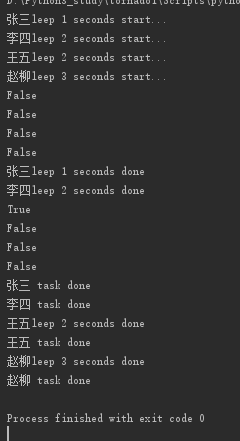Python 线程池模块threadpool 、 concurrent.futures 的 ThreadPoolExecutor
一、threadpool 基本用法
pip install threadpool
pool = ThreadPool(poolsize)
requests = makeRequests(some_callable, list_of_args, callback)
[pool.putRequest(req) for req in requests]
pool.wait()
第一行定义了一个线程池,表示最多可以创建poolsize这么多线程;
第二行是调用makeRequests创建了要开启多线程的函数,以及函数相关参数和回调函数,其中回调函数可以不写,default是无,也就是说makeRequests只需要2个参数就可以运行;
第三行使用列表生成式代替for循环,是将所有要运行多线程的请求扔进线程池,
[pool.putRequest(req) for req in requests]等同于
for req in requests:
pool.putRequest(req)
第四行是等待所有的线程完成工作后退出。
二、代码实例
要处理的函数,只需要一个传参:
import time
import threadpool
def sayhello(str):
print "Hello ",str
time.sleep(2) name_list =['xiaozi','aa','bb','cc']
start_time = time.time()
pool = threadpool.ThreadPool(10)
requests = threadpool.makeRequests(sayhello, name_list)
[pool.putRequest(req) for req in requests]
pool.wait()
print '%d second'% (time.time()-start_time)
要处理的函数,只需要N个传参:
方式一:---参数列表元素需要用元组,([args,...], None)
import time
import threadpool
def sayhello(a, b, c):
print("Hello ",a, b, c)
time.sleep(2) def call_back():
print('call_back...........') name_list = [([1,2,3], None), ([4,5,6], None) ] start_time = time.time()
pool = threadpool.ThreadPool(10)
requests = threadpool.makeRequests(sayhello, name_list)
[pool.putRequest(req) for req in requests]
pool.wait()
print('%d second'% (time.time()-start_time))
Hello 1 2 3
Hello 4 5 6
2 second
Process finished with exit code 0
方式二:---参数列表元素需要用元组,(None, {'key':'value', .......})
import time
import threadpool
def sayhello(a, b, c):
print("Hello ",a, b, c)
time.sleep(2) def call_back():
print('call_back...........') # name_list = [([1,2,3], None), ([4,5,6], None) ]
name_list = [(None, {'a':1,'b':2,'c':3}), (None, {'a':4,'b':5, 'c':6}) ] start_time = time.time()
pool = threadpool.ThreadPool(10)
requests = threadpool.makeRequests(sayhello, name_list)
[pool.putRequest(req) for req in requests]
pool.wait()
print('%d second'% (time.time()-start_time))
concurrent.futures 的ThreadPoolExecutor (线程池)
https://www.jianshu.com/p/6d6e4f745c27
从Python3.2开始,标准库为我们提供了 concurrent.futures 模块,它提供了 ThreadPoolExecutor (线程池)和ProcessPoolExecutor (进程池)两个类。
相比 threading 等模块,该模块通过 submit 返回的是一个 future 对象,它是一个未来可期的对象,通过它可以获悉线程的状态主线程(或进程)中可以获取某一个线程(进程)执行的状态或者某一个任务执行的状态及返回值:
- 主线程可以获取某一个线程(或者任务的)的状态,以及返回值。
- 当一个线程完成的时候,主线程能够立即知道。
- 让多线程和多进程的编码接口一致。
线程池的基本使用
#!/usr/bin/env python3
# -*- coding:utf-8 -*-
# @Time: 2020/11/21 17:55
# @Author:zhangmingda
# @File: ThreadPoolExecutor_study.py
# @Software: PyCharm
# Description: from concurrent.futures import ThreadPoolExecutor
import time task_args_list = [('zhangsan', 2),('lishi',3), ('wangwu', 4)]
def task(name, seconds):
print('% sleep %s seconds start...' % (name, seconds))
time.sleep(seconds)
print('% sleep %s seconds done' % (name, seconds))
return '%s task done' % name with ThreadPoolExecutor(max_workers=5) as t:
# [ t.submit(task, *arg) for arg in task_args_list]
task1 = t.submit(task, '张三', 1)
task2 = t.submit(task, '李四', 2)
task3 = t.submit(task, '王五', 2)
task4 = t.submit(task, '赵柳', 3)
print(task1.done())
print(task2.done())
print(task3.done())
print(task4.done())
time.sleep(2)
print(task1.done())
print(task2.done())
print(task3.done())
print(task4.done()) print(task1.result())
print(task2.result())
print(task3.result())
print(task4.result())

使用 with 语句 ,通过 ThreadPoolExecutor 构造实例,同时传入 max_workers 参数来设置线程池中最多能同时运行的线程数目。
使用 submit 函数来提交线程需要执行的任务到线程池中,并返回该任务的句柄(类似于文件、画图),注意 submit() 不是阻塞的,而是立即返回。
通过使用 done() 方法判断该任务是否结束。上面的例子可以看出,提交任务后立即判断任务状态,显示四个任务都未完成。在延时2.5后,task1 和 task2 执行完毕,task3 仍在执行中。
使用 result() 方法可以获取任务的返回值 【注意result 是阻塞的会阻塞主线程】
主要方法:
wait
wait(fs, timeout=None, return_when=ALL_COMPLETED)
fs: 表示需要执行的序列
timeout: 等待的最大时间,如果超过这个时间即使线程未执行完成也将返回
return_when:表示wait返回结果的条件,默认为 ALL_COMPLETED 全部执行完成再返回;可指定FIRST_COMPLETED 当第一个执行完就退出阻塞
from concurrent.futures import ThreadPoolExecutor,wait,FIRST_COMPLETED, ALL_COMPLETED
import time task_args_list = [('zhangsan', 1),('lishi',2), ('wangwu', 3)]
task_list = [] def task(name, seconds):
print('% sleep %s seconds start...' % (name, seconds))
time.sleep(seconds)
print('% sleep %s seconds done' % (name, seconds))
return '%s task done' % name with ThreadPoolExecutor(max_workers=5) as t:
[task_list.append(t.submit(task, *arg)) for arg in task_args_list]
wait(task_list, return_when=FIRST_COMPLETED) # 等了一秒
print('all_task_submit_complete! and First task complete!')
print(wait(task_list,timeout=1.5)) # 又等了1.5秒,合计等了2.5秒

as_completed
上面虽提供了判断任务是否结束的方法,但是不能在主线程中一直判断。最好的方法是当某个任务结束了,就给主线程返回结果,而不是一直判断每个任务是否结束。
task_args_list = [('zhangsan', 1),('lishi',3), ('wangwu', 2)]
task_list = []
def task(name, seconds):
print('%s sleep %s seconds start...' % (name, seconds))
time.sleep(seconds)
return '%s sleep %s seconds done' % (name, seconds)
with ThreadPoolExecutor(max_workers=5) as t:
[task_list.append(t.submit(task, *arg)) for arg in task_args_list]
[print(future.result()) for future in as_completed(task_list)]
print('All Task Done!!!!!!!!!')

map
map(fn, *iterables, timeout=None)
fn: 第一个参数 fn 是需要线程执行的函数;
iterables:第二个参数接受一个可迭代对象;
timeout: 第三个参数 timeout 跟 wait() 的 timeout 一样,但由于 map 是返回线程执行的结果,如果 timeout小于线程执行时间会抛异常 TimeoutError。
用法如下:
def spider(page):
time.sleep(page)
return page start = time.time()
executor = ThreadPoolExecutor(max_workers=4) i = 1
for result in executor.map(spider, [2, 3, 1, 4]):
print("task{}:{}".format(i, result))
i += 1 # 运行结果
task1:2
task2:3
task3:1
task4:4
使用 map 方法,无需提前使用 submit 方法,map 方法与 python 高阶函数 map 的含义相同,都是将序列中的每个元素都执行同一个函数。
上面的代码对列表中的每个元素都执行 spider() 函数,并分配各线程池。
可以看到执行结果与上面的 as_completed() 方法的结果不同,输出顺序和列表的顺序相同,就算 1s 的任务先执行完成,也会先打印前面提交的任务返回的结果。
Python 线程池模块threadpool 、 concurrent.futures 的 ThreadPoolExecutor的更多相关文章
- python线程池(threadpool)
一.安装 pip install threadpool 二.使用介绍 (1)引入threadpool模块 (2)定义线程函数 (3)创建线程 池threadpool.ThreadPool() (4)创 ...
- python线程池(threadpool)模块使用笔记
一.安装与简介 pip install threadpool pool = ThreadPool(poolsize) requests = makeRequests(some_callable, li ...
- python线程池(threadpool)模块使用笔记 .python 线程池使用推荐
一.安装与简介 pip install threadpool pool = ThreadPool(poolsize) requests = makeRequests(some_callable, li ...
- Python 线程池(小节)
Python 线程池(小节) from concurrent.futures import ThreadPoolExecutor,ProcessPoolExecutor import os,time, ...
- Python之路(第四十六篇)多种方法实现python线程池(threadpool模块\multiprocessing.dummy模块\concurrent.futures模块)
一.线程池 很久(python2.6)之前python没有官方的线程池模块,只有第三方的threadpool模块, 之后再python2.6加入了multiprocessing.dummy 作为可以使 ...
- python3 线程池-threadpool模块与concurrent.futures模块
多种方法实现 python 线程池 一. 既然多线程可以缩短程序运行时间,那么,是不是线程数量越多越好呢? 显然,并不是,每一个线程的从生成到消亡也是需要时间和资源的,太多的线程会占用过多的系统资源( ...
- Python3【模块】concurrent.futures模块,线程池进程池
Python标准库为我们提供了threading和multiprocessing模块编写相应的多线程/多进程代码,但是当项目达到一定的规模,频繁创建/销毁进程或者线程是非常消耗资源的,这个时候我们就要 ...
- python并发模块之concurrent.futures(一)
Python3.2开始,标准库为我们提供了concurrent.futures模块,它提供了ThreadPoolExecutor和ProcessPoolExecutor两个类,实现了对threadin ...
- Python之网络编程之concurrent.futures模块
需要注意一下不能无限的开进程,不能无限的开线程最常用的就是开进程池,开线程池.其中回调函数非常重要回调函数其实可以作为一种编程思想,谁好了谁就去掉 只要你用并发,就会有锁的问题,但是你不能一直去自己加 ...
随机推荐
- nginx安装与配置3-反向代理两台
1.nginx 反向代理 两台tomcat 2.8080.8081 启动tomcat 记住每个tomcat都有两个端口不要出现tomcat端口占用情况 3.启动项目访问,不报错可以访问 4.在每个to ...
- CSS Web Fonts 网络字体
Fonts 1. CSS font-family 在 CSS 中,可以使用 font-family 属性来指定字体,浏览器渲染文字时候会根据这个属性应用于元素.如果没有指定这个属性或者指定的字体不存在 ...
- vue使用axios读取本地json文件来显示echarts折线图
编辑器:HBuilderx axios文档:http://www.axios-js.com/zh-cn/docs/ echarts实例:https://echarts.apache.org/examp ...
- JSOI 2008 最小生成树计数
JSOI 2008 最小生成树计数 今天的题目终于良心一点辣 一个套路+模版题. 考虑昨天讲的那几个结论,我们有当我们只保留最小生成树中权值不超过 $ k $ 的边的时候形成的联通块是一定的. 我们可 ...
- Scrapy框架延迟请求之Splash的使用
Splash是什么,用来做什么 Splash, 就是一个Javascript渲染服务.它是一个实现了HTTP API的轻量级浏览器,Splash是用Python实现的,同时使用Twisted和QT.T ...
- Browse Code Answers
一个记录各种语言可能遇到的问题的论坛 :https://www.codegrepper.com/code-examples/
- window文件挂载到linux
- 《手把手教你》系列技巧篇(四十六)-java+ selenium自动化测试-web页面定位toast-下篇(详解教程)
1.简介 终于经过宏哥的不懈努力,偶然发现了一个toast的web页面,所以直接就用这个页面来夯实一下,上一篇学过的知识-处理toast元素. 2.安居客 事先声明啊,宏哥没有收他们的广告费啊,纯粹是 ...
- CSS区分Chrome和Firefox
CSS区分Chrome和FireFox 描述:由于Chrome和Firefox浏览器内核不同,对CSS解析有差别,因此常会有在两个浏览器中显示效果不同的问题出现,解决办法如下: /*Chrome*/ ...
- 数据库之JDBC
1.简单认识一下JDBC 1).JDBC是什么? java database connection java数据库连接 作用:就是为了java连接mysql数据库嘛 要详细的,就面向百度编 ...
